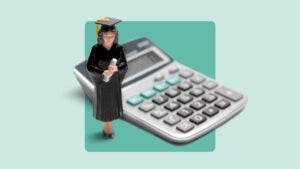Why Black women are the most affected by student debt and possible forgiveness

A previous Bankrate survey found that 59 percent of U.S. adults with student loan debt have put off financial decisions because of that debt. This number was even higher at 64 percent among Black respondents. Student loan debt has also been identified as a major contributor to racial disparity in homeownership. White American households have a homeownership rate of 75 percent, while Black American households have a homeownership rate of 45 percent.
Women owe nearly two-thirds of America’s student debt despite enrolling in higher education at similar rates as men, and more than 70 percent of Black students go into debt to pay for their education. The reasons for these disparities ultimately come down to systemic racism and sexism when trying to build generational wealth.
“Black women, in particular, live at the intersection of sexism and racism. This is the result of systemic racism, not to mention stereotypes and discrimination and bias that has made the fact that black women are receiving degrees at higher rates, etc., but are not seeing the benefits.”
— Gloria L. Blackwell CEO of the American Association of University Women (AAUW)
Student debt contributes to gender and racial wealth gaps
Women, particularly Black women, tend to have more student debt because they earn less than white men on average and typically have to be more educated to reach similar positions.
“Black women have to earn at least a bachelor’s degree or higher to earn more than white men who might have some college but don’t even have a degree,” says Blackwell. “And that’s important because Black women just have to have stronger credentials in order to compete in today’s labor market.”
- Black women graduate with $37,558 of student debt on average, compared to $22,000 owed by women overall and $18,880 owed by men overall.
- Women take an average of two years longer than men to pay off their student loans.
- Black borrowers with a four-year degree are five times more likely to default on their loans than white borrowers.
- 57% of Black women with college degrees report having financial difficulties while trying to pay off student debt.
- Black college graduates owe an average of $25,000 more in student loan debt than white college graduates.
- 48% of Black borrowers owe about 6% more than they borrowed four years after graduating.
- Women who work full time and have Bachelor’s degrees make about 26% less than their male peers.
These disparities can reasonably be attributed, in part, to the gender pay gap. In 2022, 48 percent of employed women had at least a bachelor’s degree, compared to 41 percent of employed men. Despite earning degrees at a higher rate than men, women continue to earn significantly less than men on average. Black women earned 70 percent as much as white men in 2022, compared to 83 percent for white women.
Earning less and taking on more debt makes it harder for Black women to build wealth. The current economic environment of high inflation, high cost of living and high tuition costs only makes matters worse. Rising inflation and student loan debt have made it much more difficult for young Americans to accrue wealth and meet financial milestones. Meanwhile, the cost of attending college has increased by 103 percent since 1987, and the average household income has only increased by about 14 percent.
As the U.S. heads toward a possible recession and the cost of higher education continues to rise, broad student debt cancellation is a crucial step to secure the economic futures of millions. This is particularly true for Black women, who must contend with institutional biases on top of these broader economic concerns.
How will broad student debt relief impact Black women?
Student loan debt is a major contributor to the racial and gender wealth gaps in America, and notable non-profit organizations such as the AAUW, the ACLU and the NAACP have long been calling on lawmakers to cancel student debt and revise policies that harm women and people of color.
Advocacy work is one of the key pillars of the AAUW, and student loan forgiveness is one of their top priorities.
“All of the advocacy that we do around higher education, particularly around student loan debt, and trying to have lawmakers understand the value in ensuring that that debt is no longer a burden is because of the disproportionate impact, in particular, that it has on women and Black women in particular, and the impact that it will have — the life-changing impact that it will have if student loan debt forgiveness and cancellation is taking place,” says Blackwell.
When the application for Biden’s one-time student debt relief plan was open, 26 million people applied or were automatically eligible. The White House estimates that nearly 90 percent of these relief benefits will go to borrowers making less than $75,000 annually. Borrowers who received a Pell Grant stand to gain the most from one-time student debt forgiveness, and Black borrowers are twice as likely to receive Pell Grants as white borrowers.
The future of Biden’s student debt relief program is unclear, and the Department of Education has predicted a historically high rise in defaults and delinquencies when the payment pause ends. Many advocacy groups and experts believe that student debt cancellation is the important first step toward making education and the labor market more equitable.
“If we don’t have that broad, equitable student debt cancellation, then there will just be pockets of change, right? We will, if we’re talking about increasing generational wealth, if we’re talking about the ability to pay down debt, and at least improve credit scores, if we’re talking about being able to pay everyday expenses, like rent and childcare, to have any really measurable impact on all of those things, we would want to see a cancellation and the bolstering of federal grants,” says Blackwell.
The need for systemic change in higher education policies
Student loan debt cancellation is only one aspect of the broader discussion on student debt. Policymakers should also examine higher education holistically and make policy changes that lead to greater equity and student success.
“We also are thinking not just about students who currently have debt. We’re doing advocacy as well for those who would like to pursue higher education and future borrowers have to be on the table,” says Blackwell.
Some of the most prevalent concerns for current students and future borrowers include expanding the Pell Grant program, state investment in higher education, improving income-driven repayment and regulating the practices of for-profit colleges.
Updates to income-driven repayment
With one-time student debt forgiveness tied up in court, the Biden administration and the Department of Education have made other efforts to address the student debt crisis.
These measures include adjustments to income-driven repayment intended to cut down monthly payments for borrowers. They specifically announced changes to the REPAYE program. Borrowers who make less than $30,600 a year would have their monthly payments cut to $0, and other borrowers could see their payments cut in half. The Department of Education aims to finalize these changes by the end of 2023.
The Department also recently extended the deadline to qualify for its one-time IDR waiver by consolidating commercially-held Perkins, FFELP and Health Education assistance loans.
While these steps are beneficial, more improvements could help. A recent report from The AAUW recommends that the formula be changed to protect more of a borrower’s income and that the discretionary income threshold be increased.
The cost of attending college
Tuition costs increase yearly, while state investment in public higher education has declined since 2008. To make higher education accessible and equitable, states should reinvest in public colleges and universities.
“We are looking at the states and the institutions themselves and the way that tuition has increased. So we want states to invest more. Our branches do quite a bit of outreach at the state level to increase the budgets for higher education as well as public education as a whole,” says Blackwell. “We definitely are lobbying to get tuition lower and are definitely looking at making sure that college affordability is something that is a mainstay of our advocacy.”
For-profit colleges strongly impact student debt, particularly for borrowers of color. Students who attend for-profit colleges tend to have higher rates of student debt and a harder time paying it off. Meanwhile, only 23 percent of students at for-profit colleges graduate within six years. Students of color are more likely to attend these institutions than white students.
The Department of Education has debt relief programs for students defrauded or misled by these institutions. The Biden administration recently announced that it would take steps to hold private college leaders responsible for their school’s unpaid federal student debt.
Broadening resources for low-income students
To truly make higher education more equitable and accessible to all students, policymakers must broaden the resources available for low-income students. This includes expanding the Pell Grant program to help students from low-income backgrounds afford college without debt. It also includes making it easier for students to qualify for income-driven repayment programs.
As it stands, programs like the Pell Grant and income-driven repayment are not having a broad enough impact on the people who need them most.
“Whether it’s income-driven repayment plans, or the pay gap or cancellation: all of these things need to be taken into consideration. Because we know that the debt looks different across different populations, and we don’t want those who are disproportionately impacted by the debt to somehow get overlooked if there’s cherry picking or only certain parts of the plan are put into place.”
— Gloria L. Blackwell CEO of the American Association of University Women (AAUW)
Resources for Black women with student debt
Given the discrimination and obstacles women, particularly women of color, likely face in higher education and the workforce, access to additional funding and resources is important. Several organizations in the U.S. provide fellowships, grants and educational training and programs specifically for women and people of color.
The AAUW is a membership-based organization with over 600 branches across the U.S. In addition to their research and advocacy work, the AAUW awarded over $6 million in fellowships and grants to over 300 people last year. It offers several programs, including some specifically for women and girls of color, to promote educational and economic equity for girls and women. The funding and resources the AAUW offers make a huge difference in the lives of many.
“But we also know that people can’t negotiate their way out of racism, discrimination, bias and stereotypes,” says Blackwell, “But we can give them some tools to put in their pocket in order to enter into the conversation with the information that can support a very strong negotiation.”
The bottom line
While there is a significant need for higher education reform overall, broad student debt cancellation could transform the lives of many for the better. Funding and training programs from organizations like the AAUW can do a lot for individual students and borrowers, but it will take broad and equitable student debt cancellation to begin solving the larger systemic issue.
“We still see across the board, college education is promoted as the pathway to equal economic opportunity, and of course, that only exists as truth for some,” says Blackwell. “We want to make sure that society will benefit when all students can build an economic safety net, when they’re able to contribute to the economy, and that it should be affordable for all, not just for an elite few. And women really shouldn’t have to sacrifice their financial future with overwhelming debt just to get an education.”
You may also like

How to spot student loan scams: 2024 guide

Why is college so expensive? 3 Reasons why




